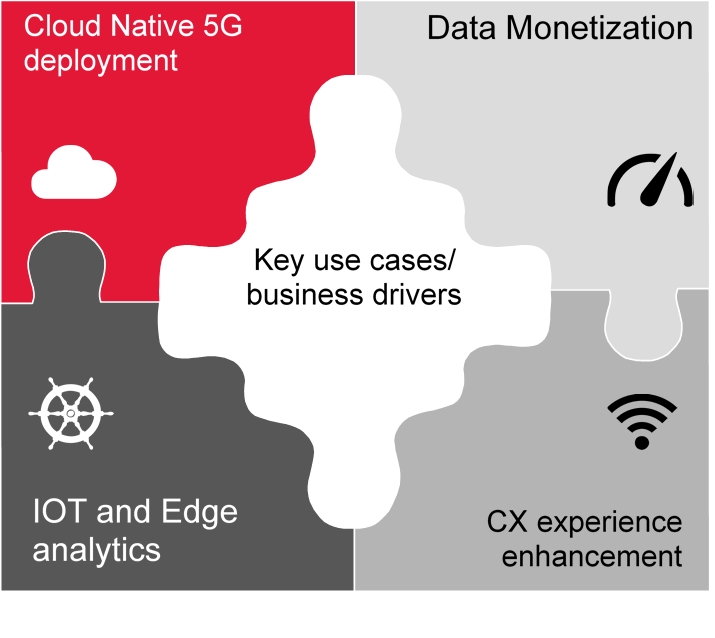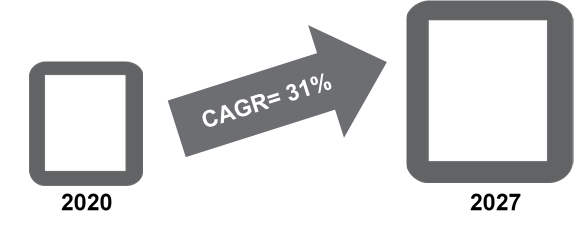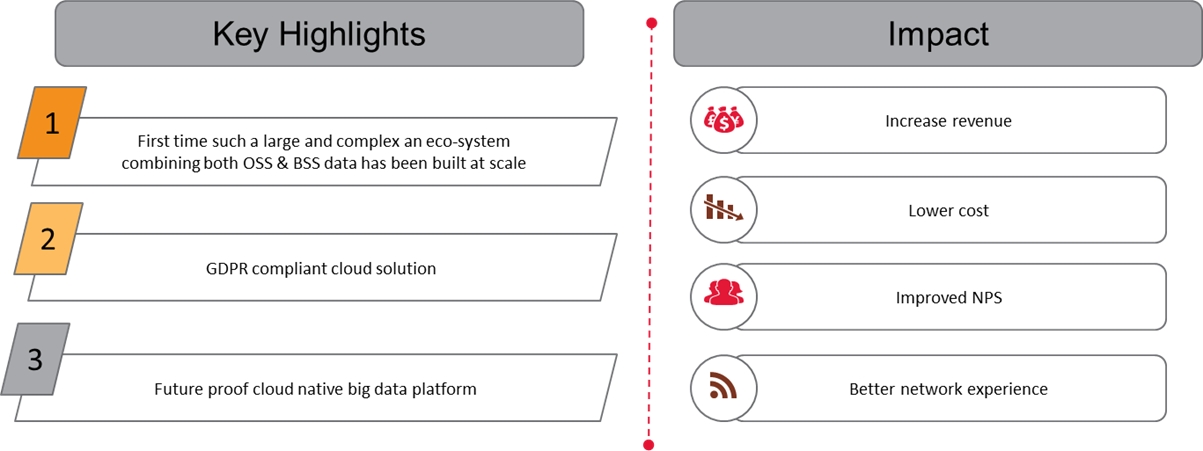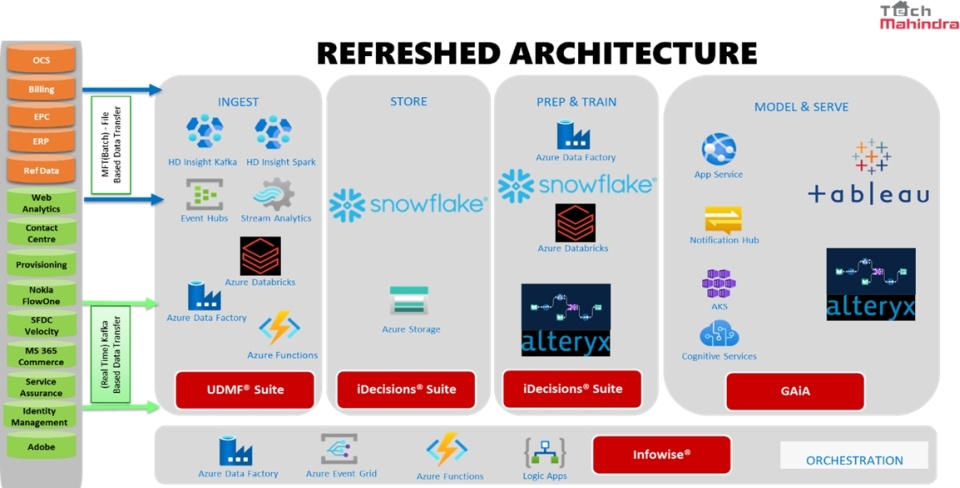Industry Thought Leadership
Big Data on Cloud for Telecom
June, 2021With the increasing adoption of smartphones and growth in mobile internet, Telecom operators today have access to exceptional amounts of data sources including – customer profiles, device data, network data, customer usage patterns, location data, apps downloaded etc. Big data is any data with 3Vs. Volume, Variety and Velocity. Communication service providers, network equipment providers and the connected world are generating big data on an extraordinary scale which provides huge opportunity for Telecom operators to get deeper insights into customer behavior, their usage patterns, preferences, interests and carve out services that are dynamic and targeted towards multiple verticals.

Telecom operators today, have the opportunity to leverage this big data to improve growth, increase efficiency and profitability across the entire telecom value chain. Traditionally, telecom operators across the globe were leveraging big data on cloud to lower capital and operational cost, increase IT agility and for business continuity purposes. Now big data on cloud is expanding being utilized to drive income development.
Global telecom analytics (primarily driven by big data) market is expected to be valued at USD 11 Billion in 2027 growing at a compounded annual growth rate (CAGR) of 14.7% from 2020.

We do imagine the future where telecommunication service providers will have lattice of data driven cloud native services which are adapted for vertical explicit requirements. These services will need and drive reception of Big Data Centric Networks which are worked to help the rising systems administration needs of associated APIs, service orchestration, cloud-driven models, real-time correspondence, Machine Learning (ML), and Artificial Intelligence (AI).
Business Drivers
Following use cases are some of the key business drivers to initiate deployment and adoption of Big data and AI centered services that will build a significant competitive advantage and market leadership in the years to come.
1. Cloud Native 5G Deployment
5G is inherently service centric, in the sense that network is designed keeping in mind the target service(s) beyond traditional voice and data. Network slicing becomes core of enabling these services for different usage and performance characteristics. Telcos looking to embrace 5G, should leverage Cloud and Big Data to re-deploy their IT Architectures to build modular cloud native big data driven services that will enable dynamic network slicing based on use case driven architectures. Imagine building a set of data driven micro-services for enabling session management, policy control, chargeback modelling, mobility service management etc. all connected as HTTP endpoints, with an additional layer of operator and partner driven application specific services that are focused on consumer and specific enterprise needs.
E.g., Set of network services targeted towards consumer or retail industry Vs set of services targeted towards enterprise needs.

2. Data Monetization
Data Monetization involves creating new revenue streams by making data available to customers and partners as packaged services. Telcos have access to demographics of customers, geo-location, network use, device use, preferences, etc. When this data is processed & modelled, they generate deep insights that can be useful for various industries and verticals and help generate new sources of revenue for Telcos.
Smart city applications: In Europe, one of the IT service providers and a large telco are working together to build smarter cities. Their integrated solutions portfolio enable municipalities to make smarter use of their services through intelligent data capture and analysis. It will likewise improve the personal satisfaction for residents, who would want to expect traffic postponements and transport or train appearances when voyaging, discover public parking spaces even more effectively, and so on.
Targeted Marketing: Telecom operators are also influencing the retail industry by developing multi-channel marketing campaigns with real-time geo-location services to target and personalize shopping experience. E.g. network operator in the US analyzes people that pass by a billboard at a particular time of the day.
Few other examples include Fraud detection for credit card companies, Geotargeting and geofencing for retailers and tourism, IoT (Internet of Things) applications for a variety of industries.
Successful data monetization approach will need to focus on the high-value opportunities that are consistent with a company’s overall business strategy. Enabling these kind of new age services will require extensive maturity in Big Data on Cloud so that Telcos can leverage and exploit these opportunities with speed, agility and assurance.
3. IoT and Edge Analytics
Edge analytics is the collection, processing, and analysis of data at the edge of a network either at or close to a sensor, a network switch or some other connected device. Sensors, smart technology, and other connected devices would not be effective if their entire data analysis process involved sending back information to a central location and waiting for it to be processed and returned. Edge analytics handles the bulk of analysis on-site, usually in a nearby connected network switch or device, and only transmitting the most important data back to a central server. IoT edge analytics allows network controllers to have a much better real-time picture of how devices and sensors are operating. E.g. a device that controls the temperature of a refrigerator at a supermarket could detect a risky change in internal temperature that could cause damage to products in seconds. With edge analytics, the same problem could be resolved in a few seconds with the sensor instantly relaying the problem and implementing a solution. A study has found that delay in loading web pages and starting YouTube videos causes stress levels similar to that caused by a horror movie. With enhance edge computing customers can be provided personalized browsing experience.

The global edge analytics market is expected to grow at a CAGR of 31% till 2027.
4. Customer experience enhancement
Telecom operators are leveraging big data analytics to enhance customer experience and standout in the market. The migration of their data systems to cloud has enabled operators to proactively address customer pain points. The operators are now able to deploy new technologies like AI/ML to predict churn, analyze network issues, detect billing anomalies, assess customer sentiments to provide ‘wow’ experience to the customer. There have been cases where telecom operators have been able to reduce churn by upto 15%2, improve NPS by 24 points . A leading US Telco has deployed big data and AI enabled enterprise solution which provides personalized experience to customer based on their previous interactions across channels. An European Operator has rolled out remote customer assistance technology, powered by AI and AR, that allows agents to see exactly what the customer sees to lower their dispatch rate by 26%.3
Tech Mahindra Value Proposition
Tech Mahindra offers mature set of capabilities that can help transform telecom operators into cutting edge age telecom services organizations. Whether its building set of cloud native modular services that form the core of Network Slicing to building sophisticated data and AI enabled insights to drive segment of targeted application services, Tech Mahindra has the competencies that can help companies succeed in the era of 5G, Edge Analytics and IoT.
Tech Mahindra has already helped several customers across verticals, move from On-Premises legacy application platforms to cloud native data driven services. Tech Mahindra has set of unique IPs that can help your Big Data Cloud transformation journey easier and faster and win in the markets.
Do you know Tech Mahindra now has the capability to strengthen business process orchestration for customers offering 5G services?
It is indeed enabled by iDecisions®, a Tech Mahindra native IP, to facilitate generation of analytical/statistical/ cognitive pursuits on data. The insights thus generated help telecom customers seamlessly manage business measurement faculties around subscriber, churn, marketing, revenue, call center, network, usage. The pinnacle of the assets dexterity is the utmost focus on QoS (quality of Service).
Tech Mahindra offers iDecisions®, an advanced analytics "Business KPI orchestration framework” for rapid and reliable business decisions. Fostering the culture of “data driven organization”, it provides blueprint for advanced analytical capability, while fast tracking DevOps and DataOps life cycle across “on premise”, cloud and hybrid eco systems.
HIGHLIGHTS

Here is one of our high impact case study
1. Large Teleco in UK Case Study: Migration from Oracle Exadata to cloud-based Snowflake
Tech Mahindra assisted a large teleco in UK to successfully transforming its data architecture to big data on cloud
Key Drivers:
The organization had a fragmented and a very MIS (Management Information Systems) oriented BI (Business Intelligence), reporting and analytics ecosystem resulting in operational inefficiencies and lack of agility. The current Data & Analytics function’s inability to provide timely insights to business functions to help drive customer satisfaction, cost efficiencies, and underpin related business imperatives. The organization wanted new Insights and Analytics platform, which would give them the technical capabilities and services to allow them to have the strategic alignment to their organizational objectives (help them drive up NPS, increase ARPU and EBIDTA and help them become the most loved communications brand in UK). The organization wanted a future proof integrated platform that supports big data processing and AI/ML to improve the turnaround times across various functions like networks, finance, operations, sales and marketing.
The solution:
- Tech Mahindra proposed a single Big Data Lake to be built from where both OSS and BSS based applications would be able to source the data and use/consume it for their needs. This was particularly important to cater to 5G and IoT uses cases.
- Tech Mahindra leveraged its IP iDecisions® to build the core Data Model for the Insights & Analytics platform which would consume data from the new CRM (customer relationship management), billing and charging, provisioning, enterprise product catalog and other systems seamlessly.
- Tech Mahindra built a kafka based event streaming architecture which would enable the data to be passed, processed, transformed and loaded in the Insights platform that could be used by Business for reporting & analytics as well other downstream applications for campaign management and other activities
- The entire solution was designed to be compliant with stringent GDPR policies
Outcome:
- Cloud-native: Enabled the organization to move all their systems and data to cloud
- Lower TCO (total cost of ownership): Resulted in closure of multiple on premise systems(BI-DWHs) and there by bringing in cost efficiencies
- Improved operations: The new eco-system is now able to have all the data, related to Customer, Products, Services, Location/Site at one place and is able to process it extremely quickly and are able to deliver different Business Outcomes i.e. real time Campaign using network information or data streaming by the customer
- Unlocked new uses cases: The organization is now able to use location data (catering to GDPR guidelines) to be able to address issues that customers are facing be it related to streaming data or call drops or any other services.>
- Improved network experience: The new Insights system helps the organization to proactively address / anticipate any Quality of Service challenges and avoid client churn. They know when the QoS drops below the thresholds irrespective of whether the customer raises a ticket or not and proactively reach out with resolution.


